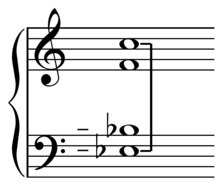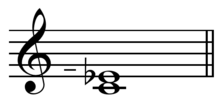Minor third
| Inverse | major sixth |
|---|---|
| Name | |
| Other names | sesquitone |
| Abbreviation | m3 |
| Size | |
| Semitones | 3 |
| Interval class | 3 |
| Just interval | 6:5, 19:16, 32:27[1] |
| Cents | |
| 12-Tone equal temperament | 300 |
| Just intonation | 316, 298, 294 |


Inmusic theory,aminor thirdis amusical intervalthat encompasses threehalf steps,orsemitones.Staff notationrepresents the minor third as encompassing threestaff positions(see:interval number). The minor third is one of two commonly occurring thirds. It is calledminorbecause it is the smaller of the two: themajor thirdspans an additional semitone. For example, the interval from A to C is a minor third, as the note C lies three semitones above A. Coincidentally, there are three staff positions from A to C.Diminishedandaugmented thirdsspan the same number of staff positions, but consist of a different number of semitones (two and five). The minor third is askipmelodically.
Notable examples of ascending minor thirds include the opening two notes of "Greensleeves"and of"Light My Fire".
The minor third may be derived from theharmonic seriesas the interval between the fifth and sixth harmonics, or from the 19thharmonic.
The minor third is commonly used to express sadness in music, and research shows that this mirrors its use in speech, as a tone similar to a minor third is produced during sad speech.[2]It is also aquartal(based on an ascendance of one or moreperfect fourths)tertianinterval, as opposed to themajor third'squintality. The minor third is also obtainable in reference to afundamental notefrom theundertone series,while the major third is obtainable as such from theovertone series.(SeeOtonality and Utonality.)
Theminor scaleis so named because of the presence of this interval between itstonicandmediant(1st and 3rd)scale degrees. Minor chordstoo take their name from the presence of this interval built on the chord'sroot(provided that the interval of aperfect fifthfrom the root is also present or implied).
A minor third, injust intonation,corresponds to a pitch ratio of 6:5 or 315.64cents.In anequal temperedtuning, a minor third is equal to threesemitones,a ratio of 21/4:1 (about 1.189), or 300 cents, 15.64 cents narrower than the 6:5 ratio. In othermeantonetunings it is wider, and in19 equal temperamentit is very nearly the 6:5 ratio of just intonation; in more complexschismatic temperaments,such as53 equal temperament,the "minor third" is often significantly flat (being close toPythagorean tuning()), although the "augmented second"produced by such scales is often within ten cents of a pure 6:5 ratio. If a minor third is tuned in accordance with the fundamental of theovertone series,the result is a ratio of 19:16 or 297.51 cents (the nineteenth harmonic).[3]The 12-TET minor third (300 cents) more closely approximates the nineteenth harmonic with only 2.49 cents error.[4]M. Ergo mistakenly claimed that the nineteenth harmonic was the highest ever written, for the bass-trumpet inRichard Wagner'sDer Ring des Nibelungen(1848 to 1874), whenRobert Schumann's Op. 86Konzertstückfor 4 Horns and Orchestra (1849) features thetwentieth harmonic(four octaves and major third above the fundamental) in the first horn part three times.[5]
Other pitch ratios are given related names, theseptimal minor thirdwith ratio 7:6 and the tridecimal minor third with ratio 13:11 in particular.
The minor third is classed as animperfect consonanceand is considered one of the most consonant intervals after theunison,octave,perfect fifth,andperfect fourth.
Thesopranino saxophoneandE♭ clarinetsound in theconcert pitch( C ) a minor third higher than the written pitch; therefore, to get the sounding pitch one musttransposethe written pitch up a minor third. Instruments in A – most commonly theA clarinet,sound a minor third lower than the written pitch.
Pythagorean minor third[edit]

Inmusic theory,asemiditone(orPythagorean minor third)[6]is theinterval32:27 (approximately 294.13cents). It is the minor third inPythagorean tuning.The 32:27 Pythagorean minor third arises in the5-limitjustly tuned major scalebetween the 2nd and 4th degrees (in the Cmajor scale,between D and F).[7]
It can be thought of as twooctavesminus threejustly tunedfifths.It is narrower than a justly tuned minor third by asyntonic comma.Its inversion is aPythagorean major sixth.[citation needed]
See also[edit]
References[edit]
- ^Haluska, Jan (2003).The Mathematical Theory of Tone Systems,p. xxiv.ISBN0-8247-4714-3.19th harmonic, overtone minor tone.
- ^Curtis, M. E.; Bharucha, J. J. (June 2010). "The minor third communicates sadness in speech, mirroring its use in music".Emotion.10(3): 335–348.doi:10.1037/a0017928.PMID20515223.
- ^Dowsett, Peter (2015).Audio Production Tips: Getting the Sound Right at the Source,p. 3.6.3. CRC.ISBN9781317614203."The minor third, however, does not appear in the harmonic series until the nineteenth harmonic. Your ear almost expects to hear the major third ([on A:] C♯), and when that is replaced with a more distantly related note, this makes the listener feel more 'unpleasant', 'tense', or 'sad'. "
- ^Alexander J. Ellis(translatingHermann Helmholtz):On the Sensations of Tone as a Physiological Basis for the Theory of Music,p. 455. Dover Publications, New York, 1954. "16:19...The 19th harmonic, ex. 297.513 [cents]". Later reprintings:ISBN1-150-36602-8orISBN1-143-49451-2.
- ^Prout, Ebenezer(December 1, 1908). "In the Forecourts of Instrumentation ",The Monthly Musical Record.p. 268.
- ^John Fonville."Ben Johnston's Extended Just Intonation – A Guide for Interpreters ", p. 124,Perspectives of New Music,vol. 29, no. 2 (Summer 1991), pp. 106-137.
- ^Paul, Oscar(1885).A manual of harmony for use in music-schools and seminaries and for self-instruction,p. 165.Theodore Baker,trans. G. Schirmer.


